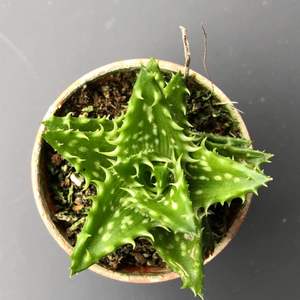Plant Experience
Detail
Aloe juvenna is a small, clump-forming succulent, with erect stem up to 12 inches (30 cm) tall and branching at the base. The leaves are bright green (reddish to brown in full sun), toothy-margined and flecked with cream-white prominent spots. The inflorescence is unbranched spike, up to 10 inches (25 cm) tall with bright coral-pink to orange-red flowers with yellow-green mouth.
Aloe is a very forgiving plant, and a well-grown plant can be quite beautiful. As with all succulents, it’s essential that Aloe is never allowed to sit in stagnant water, and the plant should be carefully monitored to watch for signs of overwatering.
Aloe are not particularly fast-growing and will only rarely need repotting. Repot plants in the spring that are tipping over their pots or have ceased growing. Use a fast-draining potting mix with one-third sand or pebbles. During repotting of a larger plant, it is possible to carefully divide the root ball. Some kinds of Aloe will send off off-sets that can be potted independently.
It needs strong, bright light. They can withstand full summer sun, once acclimated. In the winter, provide bright light. It prefers warmer temperatures of 70 to 80 °F (21 to 27 °C), but will survive down to 40 °F (4.5 °C). Feed with a cactus fertilizer in the summer only. Suspend feeding in the winter as the plant goes dormant.
Growing Conditions
Light: Strong, bright light. They can withstand full summer sun, once acclimated. In the winter, provide bright light.
Water: Water generously in the summer and nearly cease watering in the winter. Do not let water stand in the rosettes.
Temperature: Prefers warmer temperatures of 70 to 80 °F (21 to 27 °C), but will survive down to 40 °F (4.5 °C).
Soil: A well-drained potting mix is essential; use a cacti or succulent mix.
Fertilizer: Feed with a cactus fertilizer in the summer only. Suspend feeding in the winter as the plant goes dormant.
Propagation
During repotting of a larger plant, it is possible to carefully divide the root ball. Some kinds of Aloe will send off off-sets that can be potted independently.
Repotting
The plants are not particularly fast-growing and will only rarely need repotting. Repot plants in the spring that are tipping over their pots or have ceased growing.
Use a fast-draining potting mix with one-third sand or pebbles.
Aloe is a very forgiving plant, and a well-grown plant can be quite beautiful. As with all succulents, it’s essential that Aloe is never allowed to sit in stagnant water, and the plant should be carefully monitored to watch for signs of overwatering.
Aloe are not particularly fast-growing and will only rarely need repotting. Repot plants in the spring that are tipping over their pots or have ceased growing. Use a fast-draining potting mix with one-third sand or pebbles. During repotting of a larger plant, it is possible to carefully divide the root ball. Some kinds of Aloe will send off off-sets that can be potted independently.
It needs strong, bright light. They can withstand full summer sun, once acclimated. In the winter, provide bright light. It prefers warmer temperatures of 70 to 80 °F (21 to 27 °C), but will survive down to 40 °F (4.5 °C). Feed with a cactus fertilizer in the summer only. Suspend feeding in the winter as the plant goes dormant.
Growing Conditions
Light: Strong, bright light. They can withstand full summer sun, once acclimated. In the winter, provide bright light.
Water: Water generously in the summer and nearly cease watering in the winter. Do not let water stand in the rosettes.
Temperature: Prefers warmer temperatures of 70 to 80 °F (21 to 27 °C), but will survive down to 40 °F (4.5 °C).
Soil: A well-drained potting mix is essential; use a cacti or succulent mix.
Fertilizer: Feed with a cactus fertilizer in the summer only. Suspend feeding in the winter as the plant goes dormant.
Propagation
During repotting of a larger plant, it is possible to carefully divide the root ball. Some kinds of Aloe will send off off-sets that can be potted independently.
Repotting
The plants are not particularly fast-growing and will only rarely need repotting. Repot plants in the spring that are tipping over their pots or have ceased growing.
Use a fast-draining potting mix with one-third sand or pebbles.
Album (1)

kensong
2018-07-10

This is my first growing diary.


Elite Article













